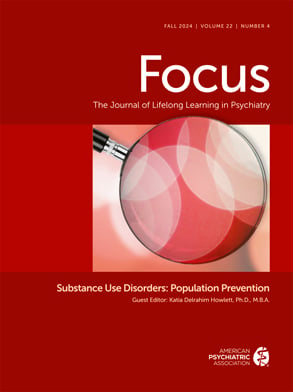Personality disorders remain, perhaps, one of the most controversial diagnostic areas in psychiatric practice. Personality, an “enduring pattern of inner experience and behavior” (
1), is disordered when patterns of thoughts, behaviors, and emotions are inflexible and maladaptive. Many individuals suffering from personality disorders demonstrate chronic high-risk behaviors, including self-injury, chronic suicidality, and episodes of poorly modulated anger outbursts. Substance abuse, eating disorders, poor functioning in school or employment, disrupted relationships, and legal involvement are not uncommon. For many patients, difficulties managing strong negative affect and the risk of acting impulsively, complicate their treatment and may elicit anxiety and a subsequent reluctance of health and mental health professionals of all disciplines to engage in the treatment of this population (
2).
Psychiatrists working with individuals with maladaptive personality functioning have a seemingly daunting task: engaging an individual for whom trust and interpersonal closeness is a primary deficit. A working understanding of issues of transference, countertransference, and projective identification is essential, as some patients may stir up strong feelings and insecurities that have the potential to disrupt the therapeutic process. Clinicians that have a clear framework for treatment engagement and process—and are able to utilize their emotional reactions to understand, clarify, and guide treatment—are the most successful (
3–
5).
Clinical Vignette
“I got a call from the ER last night,” I lamented to a colleague at the clinic. “My patient, Julia, had another suicide attempt—this time a serious overdose with her antidepressant medication. She had texted me at three in the morning, but of course I was sleeping and didn’t get it. I have told her many times to call my answering service if things are very bad!”
“I’m sorry,” my colleague empathized. He had dealt with Julia during my vacations, and knew how difficult she could be. I had also presented her case to colleagues in peer supervision. But Julia had never taken it this far before. There had been intermittent superficial cutting; she had taken an extra pill or two when upset–once she took 10 antihistamine capsules. But to take her entire new prescription of antidepressant…
“OK, I give up. I feel so inadequate. If she is going to try to kill herself on the medication I prescribe, maybe she should find another doctor!” I vented.
I felt so demoralized and, yes, even furious. Doctors weren’t supposed to let their patients get to them. Maybe I was out of my league.
“I feel like terminating her care while she is in the hospital, so they can contain her rage and help her find a better doctor at the clinic.”
“Really?” my colleague queried dumbfoundedly. “Think about what you’re saying. You just talked about her last week in peer supervision. You have started working with her to reach a shared agreement on treatment goals, and she is making slow but steady progress on that. She is starting to trust you, and wants to start trusting herself. But she has felt so dependent on others for so long; it is probably scaring her.”
“Well, now she is scaring me, and I think she needs to find another doctor,” I argued.
My colleague retorted quickly, “Of course. That’s how projective identification works. She believes that you will abandon her and projects those feelings onto you, until you absorb them and want to act on them. You know that no psychiatrist can be expected to work miracles. You and Julia both know that it is going to be a roller coaster. You just don’t like it.” Sometimes my colleague can be so reasonable, it is almost annoying.
“You’re right, of course,” I mused. “I’m not really going to ask her to find another doctor. Still, I think I could use some extra help. The crisis management team and DBT group in addition to our individual therapy work might help support us both.”
“That sounds like a plan,” my colleague said, reassuringly.
“I’ll talk to her inpatient team and see if I can go visit her this afternoon,” I resolved, taking several deep breaths.
The Engagement Process
Many health and mental health professionals of all disciplines are reluctant to treat patients for whom personality disorder is a primary diagnosis. Managing the high level of risk associated with chronic suicidality or self-defeating behaviors can be anxiety-provoking and emotionally exhausting. “An acceptance that there may be recurrent breakdowns in relationships, work and accommodation and that engagement may be difficult should be combined with a continuing commitment to the patient” (
6). The public (and sometimes the patient and even the treating psychiatrist herself) often places too high an expectation that the psychiatrist will provide instant solutions or take responsibility for all adverse behaviors.
The establishment of a physician-patient relationship that is maintained over time is a particular challenge to therapeutic engagement and treatment for individuals with impairments in personality functioning. However, this engagement, and the concomitant ability to collaborate in setting treatment goals and expectations, is core to the treatment. Treatment includes ongoing attempts to reach and maintain a shared view of expectations, so that neither the patient nor the therapist is set up to fail.
Kingsley Norton has described some of the difficulties in achieving a shared realistic set of expectations and ways of tackling them. “Consistency, tolerance, patience and understanding (without necessarily condoning) are key features of any successful management plan. This can be challenging in light of some patients’ ambivalence and difficulty engaging. Another key ingredient is the instillation of hope. However, this should not be at the expense of raising false expectations” (
7).
The issues of physician-patient communication and active engagement of the patient in her/his treatment remain primary. Engagement includes active listening; sensitivity to the individual’s culture, lifestyle, and perspective in assessment; and providing a therapeutic scaffold by which the patient and therapist may communicate openly (
8).

